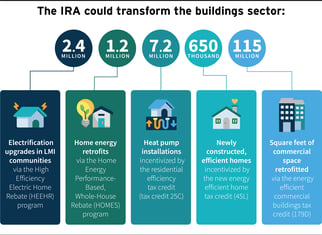 The newly passed Inflation Reduction Act (IRA) incentivizes increasing energy efficiency to decarbonize the built environment and fight climate change. All totaled, the law invests $50 billion into clean energy technologies and improvements that can lower home energy bills and make homes healthier and safer while significantly reducing climate pollution.
The newly passed Inflation Reduction Act (IRA) incentivizes increasing energy efficiency to decarbonize the built environment and fight climate change. All totaled, the law invests $50 billion into clean energy technologies and improvements that can lower home energy bills and make homes healthier and safer while significantly reducing climate pollution.
New rebates and expansion of existing energy efficiency tax credits mean more than $23 billion available to electrify homes, upgrade heating, cooling, air sealing, and insulation, as well as construct new homes that meet the highest federal standards.
By the Numbers
According to a new analysis by the Rocky Mountain Institute (RMI), the Inflation Reduction Act could mean more than 650,000 newly constructed energy-efficient homes, 2.4 million electrification upgrades, and 7.2 million heat pump additions in existing homes. Rebates and tax incentives are targeted at middle-class and low-income households, which pay a larger share of their income for utilities because of deferred maintenance and high utility costs.
For building retrofits, the IRA has financial incentives for upgrades, including tax credits and rebates. The $500 energy-efficiency upgrade tax credit previously available is still available through December 31 of this year. However, the new annual tax credit for these upgrades is boosted to 30 percent of eligible expenses up to $1,200 per year for the next ten years.
The state-run efficiency and electrification rebate programs are planned but must still be designed to roll out to consumers, which could take up to 2 years, according to RMI.
Builders Incentivized
The IRA also includes a builder credit of $2,500 for single-family homes that meet the ENERGY STAR 3.2 requirements and the prescriptive thermal envelope requirements of the 2021 IECC. That credit is boosted to $5,000 for homes that meet the DOE Zero Energy Home standard (which includes envelope standards). Builders of multi-family homes could receive a credit of $500 or $2,500 when prevailing wage requirements are met.
Conclusion
“The Inflation Reduction Act directs unprecedented levels of funding toward the critical aim of making the U.S. buildings sector climate-friendly, more affordable, healthier, and safer, “ says RMI. “However, this funding alone isn’t enough to put the sector on track to meet our climate goals. To maximize the IRA’s transformative potential, the financial incentives must be coupled with a concerted effort to design effective state and local programs that educate and attract consumers and contractors, develop the necessary workforce to meet the demand of a growing industry, and fold together existing state and utility energy efficiency and electrification programs.”
While program guidance is still to come from states, the IRA has the potential to be a game-changing initiative for the U.S. housing stock in terms of decarbonization.





